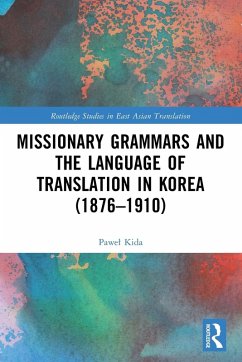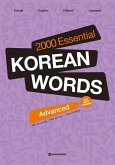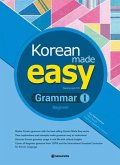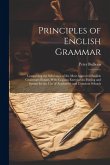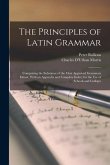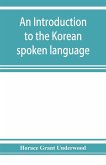Pawel Kida
Missionary Grammars and the Language of Translation in Korea (1876-1910)
Pawel Kida
Missionary Grammars and the Language of Translation in Korea (1876-1910)
- Broschiertes Buch
- Merkliste
- Auf die Merkliste
- Bewerten Bewerten
- Teilen
- Produkt teilen
- Produkterinnerung
- Produkterinnerung
Missionary Grammars and the Language of Translation in Korea 1876-1910 embraces the Enlightenment period in Korea (1876-1910) after the opening of the so-called 'Hermit Nation' in describing the Korean language and missionary works.
Andere Kunden interessierten sich auch für
![2000 Essential Korean Words Advanced 2000 Essential Korean Words Advanced]() Jin-young Min2000 Essential Korean Words Advanced31,99 €
Jin-young Min2000 Essential Korean Words Advanced31,99 €![Korean Made Easy Grammar 1 Korean Made Easy Grammar 1]() Seung-eun OhKorean Made Easy Grammar 139,90 €
Seung-eun OhKorean Made Easy Grammar 139,90 €![The Chinese Rhyme Tables The Chinese Rhyme Tables]() Pan WenguoThe Chinese Rhyme Tables52,99 €
Pan WenguoThe Chinese Rhyme Tables52,99 €![Principles of English Grammar: Comprising the Substance of the Most Approved English Grammars Extant, With Copious Exercises in Parsing and Syntax fo Principles of English Grammar: Comprising the Substance of the Most Approved English Grammars Extant, With Copious Exercises in Parsing and Syntax fo]() Peter BullionsPrinciples of English Grammar: Comprising the Substance of the Most Approved English Grammars Extant, With Copious Exercises in Parsing and Syntax fo20,99 €
Peter BullionsPrinciples of English Grammar: Comprising the Substance of the Most Approved English Grammars Extant, With Copious Exercises in Parsing and Syntax fo20,99 €![The Principles of Latin Grammar: Comprising the Substance of the Most Approved Grammars Extant, With an Appendix and Complete Index. for the Use of Sc The Principles of Latin Grammar: Comprising the Substance of the Most Approved Grammars Extant, With an Appendix and Complete Index. for the Use of Sc]() Charles D'Urban MorrisThe Principles of Latin Grammar: Comprising the Substance of the Most Approved Grammars Extant, With an Appendix and Complete Index. for the Use of Sc25,99 €
Charles D'Urban MorrisThe Principles of Latin Grammar: Comprising the Substance of the Most Approved Grammars Extant, With an Appendix and Complete Index. for the Use of Sc25,99 €![An introduction to the Korean spoken language An introduction to the Korean spoken language]() Horace Grant UnderwoodAn introduction to the Korean spoken language28,99 €
Horace Grant UnderwoodAn introduction to the Korean spoken language28,99 €![Beyond Borrowing Beyond Borrowing]() Hyejeong AhnBeyond Borrowing52,99 €
Hyejeong AhnBeyond Borrowing52,99 €-
-
-
Missionary Grammars and the Language of Translation in Korea 1876-1910 embraces the Enlightenment period in Korea (1876-1910) after the opening of the so-called 'Hermit Nation' in describing the Korean language and missionary works.
Produktdetails
- Produktdetails
- Verlag: Taylor & Francis Ltd
- Seitenzahl: 196
- Erscheinungstermin: 30. Juli 2025
- Englisch
- Abmessung: 234mm x 156mm
- ISBN-13: 9781032679679
- ISBN-10: 1032679670
- Artikelnr.: 74435365
- Herstellerkennzeichnung
- Libri GmbH
- Europaallee 1
- 36244 Bad Hersfeld
- gpsr@libri.de
- Verlag: Taylor & Francis Ltd
- Seitenzahl: 196
- Erscheinungstermin: 30. Juli 2025
- Englisch
- Abmessung: 234mm x 156mm
- ISBN-13: 9781032679679
- ISBN-10: 1032679670
- Artikelnr.: 74435365
- Herstellerkennzeichnung
- Libri GmbH
- Europaallee 1
- 36244 Bad Hersfeld
- gpsr@libri.de
Pawe¿ Kida, PhD, Chief of Korean Language Department, Faculty of Ethnolinguistics, Adam Mickiewicz University Poznä, Poland.
List of Figures
List of Tables
Acknowledgments
Preface
Preliminaries
Abbreviations
1. METAGRAMMATICAL THOUGHT
1.1. Foreign evaluation of former Korean grammar
1.2. Korean evaluation of former Korean grammar
1.3. Missionary Grammars
2. AUTHORS AND GRAMMARS' CONTENT
2.1. John Ross (1842-1915)
2.2. Felix-Clair Ridel (1830-1884)
2.3. James Scott (1850-1920)
2.4. Camille Imbault-Huart (1857-1897)
2.5. Horace Grant Underwood (1859-1916)
2.6. James Scrath Gale (1863-1937)
2.7. Annie Laurie Baird (1864-1916)
3. MORPHOSYNTACTIC MODEL
3.1. Partes Orationis
3.1.1. Noun
3.1.1.1. Case
3.1.1.2. Gender
3.1.1.3. Number
3.1.2. Pronoun
3.1.2.1. Personal
3.1.2.2. Demonstrative
3.1.2.3. Reflexive
3.1.2.4. Interrogative
3.1.2.5. Indefinite
3.1.2.6. Possessive
3.1.2.7. Relative
3.1.2.8. Distributive
3.1.3. Numeral
3.1.3.1. Cardinal
3.1.3.2. Ordinal
3.1.3.3. Fractional
3.1.3.4. Multiplicative
3.1.3.5. Classifiers
3.1.4. Verb
3.1.4.1. Voice
3.1.4.2. Mood
3.1.4.3. Tense
3.1.4.4. Conjugation
3.1.4.5. Basal Conjugation
3.1.4.6. Participle
3.1.4.7. Auxiliary Verb
3.1.4.8. Verbal noun
3.1.4.9. Gerundive/Supine
3.1.5. Adjective
3.1.5.1. Comparative degree
3.1.5.2. Superlative degree
3.1.6. Adverb
3.1.7. Postposition
3.1.8. Conjunction
3.1.9. Interjection
3.2. Sententiae Structura
3.2.1. Negation
3.2.2. Passive
3.2.3. Causative
3.2.4. Honorifics
3.2.5. Indirect Speech
Conclusions
Bibliography
Grammatical Units and Korean Words
Index
List of Tables
Acknowledgments
Preface
Preliminaries
Abbreviations
1. METAGRAMMATICAL THOUGHT
1.1. Foreign evaluation of former Korean grammar
1.2. Korean evaluation of former Korean grammar
1.3. Missionary Grammars
2. AUTHORS AND GRAMMARS' CONTENT
2.1. John Ross (1842-1915)
2.2. Felix-Clair Ridel (1830-1884)
2.3. James Scott (1850-1920)
2.4. Camille Imbault-Huart (1857-1897)
2.5. Horace Grant Underwood (1859-1916)
2.6. James Scrath Gale (1863-1937)
2.7. Annie Laurie Baird (1864-1916)
3. MORPHOSYNTACTIC MODEL
3.1. Partes Orationis
3.1.1. Noun
3.1.1.1. Case
3.1.1.2. Gender
3.1.1.3. Number
3.1.2. Pronoun
3.1.2.1. Personal
3.1.2.2. Demonstrative
3.1.2.3. Reflexive
3.1.2.4. Interrogative
3.1.2.5. Indefinite
3.1.2.6. Possessive
3.1.2.7. Relative
3.1.2.8. Distributive
3.1.3. Numeral
3.1.3.1. Cardinal
3.1.3.2. Ordinal
3.1.3.3. Fractional
3.1.3.4. Multiplicative
3.1.3.5. Classifiers
3.1.4. Verb
3.1.4.1. Voice
3.1.4.2. Mood
3.1.4.3. Tense
3.1.4.4. Conjugation
3.1.4.5. Basal Conjugation
3.1.4.6. Participle
3.1.4.7. Auxiliary Verb
3.1.4.8. Verbal noun
3.1.4.9. Gerundive/Supine
3.1.5. Adjective
3.1.5.1. Comparative degree
3.1.5.2. Superlative degree
3.1.6. Adverb
3.1.7. Postposition
3.1.8. Conjunction
3.1.9. Interjection
3.2. Sententiae Structura
3.2.1. Negation
3.2.2. Passive
3.2.3. Causative
3.2.4. Honorifics
3.2.5. Indirect Speech
Conclusions
Bibliography
Grammatical Units and Korean Words
Index
List of Figures
List of Tables
Acknowledgments
Preface
Preliminaries
Abbreviations
1. METAGRAMMATICAL THOUGHT
1.1. Foreign evaluation of former Korean grammar
1.2. Korean evaluation of former Korean grammar
1.3. Missionary Grammars
2. AUTHORS AND GRAMMARS' CONTENT
2.1. John Ross (1842-1915)
2.2. Felix-Clair Ridel (1830-1884)
2.3. James Scott (1850-1920)
2.4. Camille Imbault-Huart (1857-1897)
2.5. Horace Grant Underwood (1859-1916)
2.6. James Scrath Gale (1863-1937)
2.7. Annie Laurie Baird (1864-1916)
3. MORPHOSYNTACTIC MODEL
3.1. Partes Orationis
3.1.1. Noun
3.1.1.1. Case
3.1.1.2. Gender
3.1.1.3. Number
3.1.2. Pronoun
3.1.2.1. Personal
3.1.2.2. Demonstrative
3.1.2.3. Reflexive
3.1.2.4. Interrogative
3.1.2.5. Indefinite
3.1.2.6. Possessive
3.1.2.7. Relative
3.1.2.8. Distributive
3.1.3. Numeral
3.1.3.1. Cardinal
3.1.3.2. Ordinal
3.1.3.3. Fractional
3.1.3.4. Multiplicative
3.1.3.5. Classifiers
3.1.4. Verb
3.1.4.1. Voice
3.1.4.2. Mood
3.1.4.3. Tense
3.1.4.4. Conjugation
3.1.4.5. Basal Conjugation
3.1.4.6. Participle
3.1.4.7. Auxiliary Verb
3.1.4.8. Verbal noun
3.1.4.9. Gerundive/Supine
3.1.5. Adjective
3.1.5.1. Comparative degree
3.1.5.2. Superlative degree
3.1.6. Adverb
3.1.7. Postposition
3.1.8. Conjunction
3.1.9. Interjection
3.2. Sententiae Structura
3.2.1. Negation
3.2.2. Passive
3.2.3. Causative
3.2.4. Honorifics
3.2.5. Indirect Speech
Conclusions
Bibliography
Grammatical Units and Korean Words
Index
List of Tables
Acknowledgments
Preface
Preliminaries
Abbreviations
1. METAGRAMMATICAL THOUGHT
1.1. Foreign evaluation of former Korean grammar
1.2. Korean evaluation of former Korean grammar
1.3. Missionary Grammars
2. AUTHORS AND GRAMMARS' CONTENT
2.1. John Ross (1842-1915)
2.2. Felix-Clair Ridel (1830-1884)
2.3. James Scott (1850-1920)
2.4. Camille Imbault-Huart (1857-1897)
2.5. Horace Grant Underwood (1859-1916)
2.6. James Scrath Gale (1863-1937)
2.7. Annie Laurie Baird (1864-1916)
3. MORPHOSYNTACTIC MODEL
3.1. Partes Orationis
3.1.1. Noun
3.1.1.1. Case
3.1.1.2. Gender
3.1.1.3. Number
3.1.2. Pronoun
3.1.2.1. Personal
3.1.2.2. Demonstrative
3.1.2.3. Reflexive
3.1.2.4. Interrogative
3.1.2.5. Indefinite
3.1.2.6. Possessive
3.1.2.7. Relative
3.1.2.8. Distributive
3.1.3. Numeral
3.1.3.1. Cardinal
3.1.3.2. Ordinal
3.1.3.3. Fractional
3.1.3.4. Multiplicative
3.1.3.5. Classifiers
3.1.4. Verb
3.1.4.1. Voice
3.1.4.2. Mood
3.1.4.3. Tense
3.1.4.4. Conjugation
3.1.4.5. Basal Conjugation
3.1.4.6. Participle
3.1.4.7. Auxiliary Verb
3.1.4.8. Verbal noun
3.1.4.9. Gerundive/Supine
3.1.5. Adjective
3.1.5.1. Comparative degree
3.1.5.2. Superlative degree
3.1.6. Adverb
3.1.7. Postposition
3.1.8. Conjunction
3.1.9. Interjection
3.2. Sententiae Structura
3.2.1. Negation
3.2.2. Passive
3.2.3. Causative
3.2.4. Honorifics
3.2.5. Indirect Speech
Conclusions
Bibliography
Grammatical Units and Korean Words
Index
List of Figures
List of Tables
Acknowledgments
Preface
Preliminaries
Abbreviations
1. METAGRAMMATICAL THOUGHT
1.1. Foreign evaluation of former Korean grammar
1.2. Korean evaluation of former Korean grammar
1.3. Missionary Grammars
2. AUTHORS AND GRAMMARS' CONTENT
2.1. John Ross (1842-1915)
2.2. Felix-Clair Ridel (1830-1884)
2.3. James Scott (1850-1920)
2.4. Camille Imbault-Huart (1857-1897)
2.5. Horace Grant Underwood (1859-1916)
2.6. James Scrath Gale (1863-1937)
2.7. Annie Laurie Baird (1864-1916)
3. MORPHOSYNTACTIC MODEL
3.1. Partes Orationis
3.1.1. Noun
3.1.1.1. Case
3.1.1.2. Gender
3.1.1.3. Number
3.1.2. Pronoun
3.1.2.1. Personal
3.1.2.2. Demonstrative
3.1.2.3. Reflexive
3.1.2.4. Interrogative
3.1.2.5. Indefinite
3.1.2.6. Possessive
3.1.2.7. Relative
3.1.2.8. Distributive
3.1.3. Numeral
3.1.3.1. Cardinal
3.1.3.2. Ordinal
3.1.3.3. Fractional
3.1.3.4. Multiplicative
3.1.3.5. Classifiers
3.1.4. Verb
3.1.4.1. Voice
3.1.4.2. Mood
3.1.4.3. Tense
3.1.4.4. Conjugation
3.1.4.5. Basal Conjugation
3.1.4.6. Participle
3.1.4.7. Auxiliary Verb
3.1.4.8. Verbal noun
3.1.4.9. Gerundive/Supine
3.1.5. Adjective
3.1.5.1. Comparative degree
3.1.5.2. Superlative degree
3.1.6. Adverb
3.1.7. Postposition
3.1.8. Conjunction
3.1.9. Interjection
3.2. Sententiae Structura
3.2.1. Negation
3.2.2. Passive
3.2.3. Causative
3.2.4. Honorifics
3.2.5. Indirect Speech
Conclusions
Bibliography
Grammatical Units and Korean Words
Index
List of Tables
Acknowledgments
Preface
Preliminaries
Abbreviations
1. METAGRAMMATICAL THOUGHT
1.1. Foreign evaluation of former Korean grammar
1.2. Korean evaluation of former Korean grammar
1.3. Missionary Grammars
2. AUTHORS AND GRAMMARS' CONTENT
2.1. John Ross (1842-1915)
2.2. Felix-Clair Ridel (1830-1884)
2.3. James Scott (1850-1920)
2.4. Camille Imbault-Huart (1857-1897)
2.5. Horace Grant Underwood (1859-1916)
2.6. James Scrath Gale (1863-1937)
2.7. Annie Laurie Baird (1864-1916)
3. MORPHOSYNTACTIC MODEL
3.1. Partes Orationis
3.1.1. Noun
3.1.1.1. Case
3.1.1.2. Gender
3.1.1.3. Number
3.1.2. Pronoun
3.1.2.1. Personal
3.1.2.2. Demonstrative
3.1.2.3. Reflexive
3.1.2.4. Interrogative
3.1.2.5. Indefinite
3.1.2.6. Possessive
3.1.2.7. Relative
3.1.2.8. Distributive
3.1.3. Numeral
3.1.3.1. Cardinal
3.1.3.2. Ordinal
3.1.3.3. Fractional
3.1.3.4. Multiplicative
3.1.3.5. Classifiers
3.1.4. Verb
3.1.4.1. Voice
3.1.4.2. Mood
3.1.4.3. Tense
3.1.4.4. Conjugation
3.1.4.5. Basal Conjugation
3.1.4.6. Participle
3.1.4.7. Auxiliary Verb
3.1.4.8. Verbal noun
3.1.4.9. Gerundive/Supine
3.1.5. Adjective
3.1.5.1. Comparative degree
3.1.5.2. Superlative degree
3.1.6. Adverb
3.1.7. Postposition
3.1.8. Conjunction
3.1.9. Interjection
3.2. Sententiae Structura
3.2.1. Negation
3.2.2. Passive
3.2.3. Causative
3.2.4. Honorifics
3.2.5. Indirect Speech
Conclusions
Bibliography
Grammatical Units and Korean Words
Index
List of Figures
List of Tables
Acknowledgments
Preface
Preliminaries
Abbreviations
1. METAGRAMMATICAL THOUGHT
1.1. Foreign evaluation of former Korean grammar
1.2. Korean evaluation of former Korean grammar
1.3. Missionary Grammars
2. AUTHORS AND GRAMMARS' CONTENT
2.1. John Ross (1842-1915)
2.2. Felix-Clair Ridel (1830-1884)
2.3. James Scott (1850-1920)
2.4. Camille Imbault-Huart (1857-1897)
2.5. Horace Grant Underwood (1859-1916)
2.6. James Scrath Gale (1863-1937)
2.7. Annie Laurie Baird (1864-1916)
3. MORPHOSYNTACTIC MODEL
3.1. Partes Orationis
3.1.1. Noun
3.1.1.1. Case
3.1.1.2. Gender
3.1.1.3. Number
3.1.2. Pronoun
3.1.2.1. Personal
3.1.2.2. Demonstrative
3.1.2.3. Reflexive
3.1.2.4. Interrogative
3.1.2.5. Indefinite
3.1.2.6. Possessive
3.1.2.7. Relative
3.1.2.8. Distributive
3.1.3. Numeral
3.1.3.1. Cardinal
3.1.3.2. Ordinal
3.1.3.3. Fractional
3.1.3.4. Multiplicative
3.1.3.5. Classifiers
3.1.4. Verb
3.1.4.1. Voice
3.1.4.2. Mood
3.1.4.3. Tense
3.1.4.4. Conjugation
3.1.4.5. Basal Conjugation
3.1.4.6. Participle
3.1.4.7. Auxiliary Verb
3.1.4.8. Verbal noun
3.1.4.9. Gerundive/Supine
3.1.5. Adjective
3.1.5.1. Comparative degree
3.1.5.2. Superlative degree
3.1.6. Adverb
3.1.7. Postposition
3.1.8. Conjunction
3.1.9. Interjection
3.2. Sententiae Structura
3.2.1. Negation
3.2.2. Passive
3.2.3. Causative
3.2.4. Honorifics
3.2.5. Indirect Speech
Conclusions
Bibliography
Grammatical Units and Korean Words
Index
List of Tables
Acknowledgments
Preface
Preliminaries
Abbreviations
1. METAGRAMMATICAL THOUGHT
1.1. Foreign evaluation of former Korean grammar
1.2. Korean evaluation of former Korean grammar
1.3. Missionary Grammars
2. AUTHORS AND GRAMMARS' CONTENT
2.1. John Ross (1842-1915)
2.2. Felix-Clair Ridel (1830-1884)
2.3. James Scott (1850-1920)
2.4. Camille Imbault-Huart (1857-1897)
2.5. Horace Grant Underwood (1859-1916)
2.6. James Scrath Gale (1863-1937)
2.7. Annie Laurie Baird (1864-1916)
3. MORPHOSYNTACTIC MODEL
3.1. Partes Orationis
3.1.1. Noun
3.1.1.1. Case
3.1.1.2. Gender
3.1.1.3. Number
3.1.2. Pronoun
3.1.2.1. Personal
3.1.2.2. Demonstrative
3.1.2.3. Reflexive
3.1.2.4. Interrogative
3.1.2.5. Indefinite
3.1.2.6. Possessive
3.1.2.7. Relative
3.1.2.8. Distributive
3.1.3. Numeral
3.1.3.1. Cardinal
3.1.3.2. Ordinal
3.1.3.3. Fractional
3.1.3.4. Multiplicative
3.1.3.5. Classifiers
3.1.4. Verb
3.1.4.1. Voice
3.1.4.2. Mood
3.1.4.3. Tense
3.1.4.4. Conjugation
3.1.4.5. Basal Conjugation
3.1.4.6. Participle
3.1.4.7. Auxiliary Verb
3.1.4.8. Verbal noun
3.1.4.9. Gerundive/Supine
3.1.5. Adjective
3.1.5.1. Comparative degree
3.1.5.2. Superlative degree
3.1.6. Adverb
3.1.7. Postposition
3.1.8. Conjunction
3.1.9. Interjection
3.2. Sententiae Structura
3.2.1. Negation
3.2.2. Passive
3.2.3. Causative
3.2.4. Honorifics
3.2.5. Indirect Speech
Conclusions
Bibliography
Grammatical Units and Korean Words
Index

